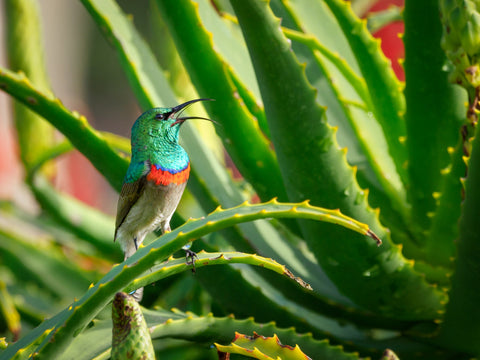Conservation Concerns: Protecting Hummingbird Habitats for Future Generations
In this blog post you'll learn tips on how to protect hummingbird habitats for future generations and much more.
The delicate and vibrant world of hummingbirds is not only a source of awe and wonder but also a vital component of our global ecosystem. These tiny creatures play a significant role as pollinators and contribute to the biodiversity of their habitats.

However, like many other species, hummingbirds face numerous challenges that threaten their survival. Conservation efforts aimed at protecting their habitats are crucial to ensure that these avian wonders continue to grace our world for generations to come.
The Significance of Hummingbirds in Ecosystems
Hummingbirds are integral pollinators in many ecosystems, playing a critical role in the reproduction of various plant species. As they feed on nectar, they inadvertently transfer pollen from flower to flower, enabling the fertilization process. This process is essential for the reproduction of plants, which in turn provides food and habitats for countless other species, including insects, mammals, and birds.
Have a friend that loves coffee and hummingbirds? Then they are sure to love this hummingbird coffee mug.
1. Habitat Loss and Fragmentation
One of the most significant threats to hummingbirds is habitat loss and fragmentation. Urbanization, deforestation, and agricultural expansion have led to the destruction of their natural habitats. As their habitats shrink or become fragmented, hummingbirds face difficulties in finding suitable food sources, nesting sites, and safe spaces.

2. Climate Change Impact
Climate change poses a significant challenge to hummingbirds. Rising temperatures, altered precipitation patterns, and shifting flowering seasons can disrupt the delicate balance between the timing of flowering plants and the arrival of hummingbird migrants. This misalignment can lead to a lack of food availability, affecting the health and survival of both hummingbirds and the plants they depend on.
3. Pesticide Use
The use of pesticides in agriculture and gardening can have detrimental effects on hummingbirds and their habitats. Pesticides not only harm the insects that hummingbirds rely on for protein but also contaminate the nectar and plant materials they consume. Pesticides can disrupt the delicate ecological relationships that hummingbirds are a part of, leading to population declines.
Looking for some hummingbird swings for your favorite birds?
4. Invasive Species
Invasive species, whether in the form of plants, animals, or diseases, can pose a serious threat to hummingbird habitats. Invasive plants can outcompete native flowering species, reducing the availability of nectar sources. Invasive animals, such as predatory birds and mammals, can disrupt the balance of the ecosystem by preying on hummingbirds and their nests.
5. Conservation Efforts
Efforts to protect and conserve hummingbird habitats are crucial for their survival. These efforts encompass a range of strategies aimed at mitigating the threats they face and creating environments where they can thrive.
Preserving Native Plants
Planting and preserving native flowering plants in gardens, parks, and natural areas can provide essential food sources for hummingbirds. Native plants are well adapted to local conditions and support the intricate relationships between hummingbirds and other species.
This hummingbird doormat is a fun way to let guests know that you love hummingbirds before stepping into your home.
Creating Protected Areas
Designating and safeguarding protected areas, such as nature reserves and wildlife sanctuaries, is vital for preserving hummingbird habitats. These areas offer safe spaces where hummingbirds can find ample food, suitable nesting sites, and protection from human disturbances.
Promoting Sustainable Practices
Promoting sustainable agricultural practices that minimize the use of pesticides and encourage habitat preservation can benefit both hummingbirds and the environment. Supporting organic farming methods and using integrated pest management techniques can reduce the negative impacts of pesticides.
Raising Awareness
Educating the public about the importance of hummingbird conservation is crucial. Increasing awareness about the threats they face and the ways individuals can contribute to their protection can inspire positive actions. Birdwatching clubs, nature organizations, and educational campaigns can play a significant role in fostering a sense of responsibility for these charismatic creatures.
Research and Monitoring
Continued research and monitoring are essential for understanding the changing dynamics of hummingbird populations and their habitats. Studying migration patterns, nesting behaviors, and the impact of environmental changes can provide valuable insights into their conservation needs.
A Shared Responsibility
Protecting hummingbird habitats is not just the responsibility of conservation organizations and governments—it's a shared responsibility that involves individuals, communities, and industries. By making conscious choices in our daily lives and advocating for conservation initiatives, we can contribute to the well-being of these remarkable birds and the ecosystems they inhabit.

A Future of Hope
While the challenges facing hummingbirds and their habitats are significant, there is hope for their conservation. The collective efforts of individuals, organizations, and governments can make a difference in preserving the biodiversity and beauty of our world. By valuing the intricate web of life that hummingbirds are a part of, we can work together to ensure that future generations have the privilege of witnessing their vibrant colors and delicate flight.
Here's a hummingbird metal rain gauge stake for your garden.
Conclusion
Conserving hummingbird habitats is not just about protecting a single species—it's about safeguarding the intricate connections that sustain life on our planet. By recognizing the value of these tiny creatures and taking action to protect their habitats, we can contribute to a more balanced and vibrant ecosystem. The beauty of hummingbirds serves as a reminder of the intricate wonders that nature has to offer, inspiring us to be stewards of the environment and advocates for its preservation.













